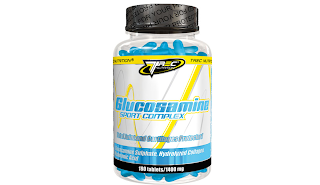Glucosamine is a popular dietary supplement that is used to treat knee osteoarthritis. While the benefits associated with glucosamine have been debated by researchers, the supplement has reduced joint pain in some patients.
There are preliminary reports that suggest the use of glucosamine with vitamin C, bromelain, chondroitin sulfate, or manganese may enhance the benefit of glucosamine for osteoarthritis. Another preliminary report suggests there may be an added benefit for psoriasis if glucosamine is taken with fish oil.
There are a lot of theories, but what are the facts? If you use glucosamine or you are considering a trial of the supplement, there are 10 things you should know about glucosamine.
1 - Glucosamine is a natural substance that is found in healthy cartilage.
Glucosamine sulfate is a normal component of glycoaminoglycans in the matrix of cartilage and in synovial fluid. Studies have shown that taking glucosamine results in pain relief equivalent to some NSAIDs. It has also been theorized that glucosamine may slow cartilage damage in osteoarthritis patients. The definite word was expected in a large clinical study conducted by the National Institutes of Health.
2 - The long awaited results from NIH Glucosamine/Chondroitin Arthritis Intervention Trial (GAIT) provided disappointing results.
GAIT was designed to test the short-term (6 months) effectiveness of glucosamine and chondroitin sulfate in reducing pain in a large number of participants with knee osteoarthritis. In GAIT, participants were randomly assigned to one of five treatment groups:
glucosamine alone
chondroitin sulfate alone
glucosamine and chondroitin sulfate in combination
celecoxib
a placebo
Results from the GAIT study showed: Participants taking the positive control, celecoxib, experienced statistically significant pain relief versus placebo. There were no significant differences between the other treatments tested and placebo. For a subset of study participants with moderate-to-severe pain, glucosamine combined with chondroitin sulfate provided statistically significant pain relief compared with placebo. Researchers, however, said that because the size of this subgroup was so small, the findings should be considered preliminary and need to be confirmed in further studies. For participants in the mild pain subset, glucosamine and chondroitin sulfate together or alone did not provide statistically significant pain relief.
3 - People who wish to try glucosamine should discuss an overall treatment plan for osteoarthritis with their doctor.
You should discuss wanting to try glucosamine with your doctor so that the doctor can keep meticulous notes about your most current treatment plan. Your doctor can also warn you about a few safety issues regarding glucosamine and keep your expectations realistic.
4 - Glucosamine is sold as a dietary supplement. The glucosamine sold as a supplement is extracted from animal tissue, specifically crab, lobster, or shrimp shells.
Most resources suggest that glucosamine should be avoided in patients who are allergic to shellfish, while other resources (including the Arthritis Foundation) recommend talking to your doctor about your known allergy. Most allergies are caused by proteins in shellfish, not by chitin, the carbohydrate from which glucosamine is extracted. Again, this is important to discuss with your doctor!
5 - If there is any chance of benefit, you must be taking the recommended theraputic amount of glucosamine.
The typical initial dose is 1500 mg of glucosamine and 1200 of chondroitin daily for 6 to 8 weeks. If a response is obtained, the dose can be reduced to 1000 mg of glucosamine and 800 of chondroitin or less. You can take glucosamine while staying on your usual arthritis medications. If there will be benefit from taking glucosamine, you should notice it within a few months.
6 - Since the dietary supplement industry is largely unregulated, the quality of glucosamine products sold is not necessarily identical.
It is recommended that you buy supplements from large, well-established companies. The company you deal with should have a good reputation. ConsumerLab.com analyzed some dietary supplements for quality and it was found that in some cases, the product did not contain the amount of the supplement that was indicated on the label. Buyer beware.
7 - If you experience common side effects, you may want to switch brands before giving up glucosamine altogether.
Common side effects associated with glucosamine include:
gas
soft stools
upset stomach
drowsiness
insomnia
headache
skin reactions
sun sensitivity
nail toughening
Glucosamine can cause a temporary increase in blood pressure and heart rate, including palpitations.
8 - It is not clear, even after several studies, whether glucosamine affects blood sugar levels
Patients with diabetes or patients who are hypoglycemic (low blood sugar) are advised to be cautious when taking glucosamine. It may be a good idea for those patients to have blood sugar levels monitored more frequently. Since glucosamine is an amino sugar, it is best to be cautious. Discuss this with your doctor.
9 - Glucosamine may increase the risk of bleeding in certain patients.
Patients with bleeding disorders, patients who take blood-thinning medications, and patients who are on daily aspirin therapy should have their blood clotting time checked more frequently to monitor the situation. Glucosamine dosage may need adjustment if a problem is discovered.
10 - Glucosamine is not recommended for use during pregnancy or breastfeeding.
Due to a lack of scientific evidence in this area, it is recommended that glucosamine be avoided during both pregnancy and breastfeeding.





